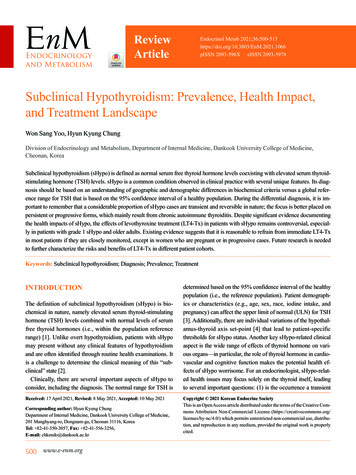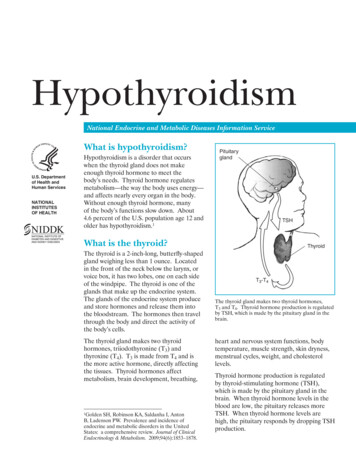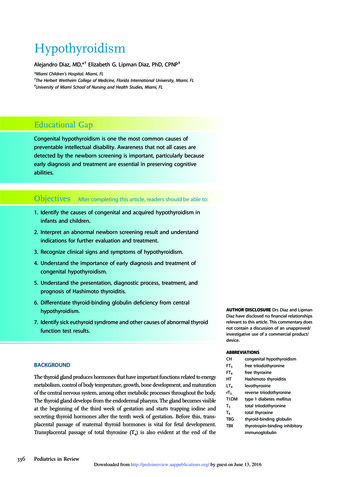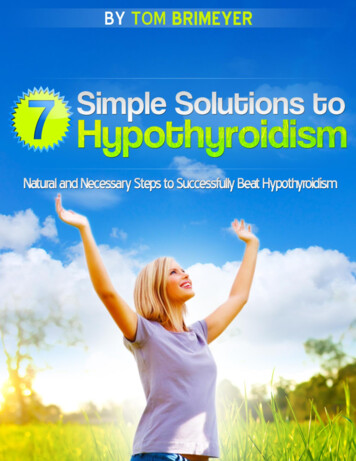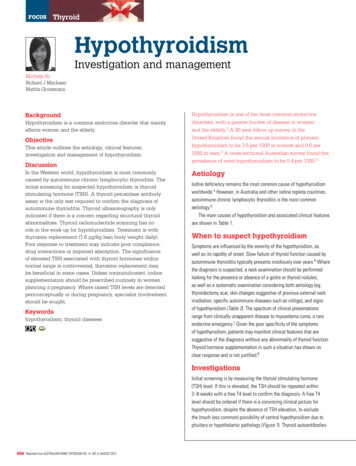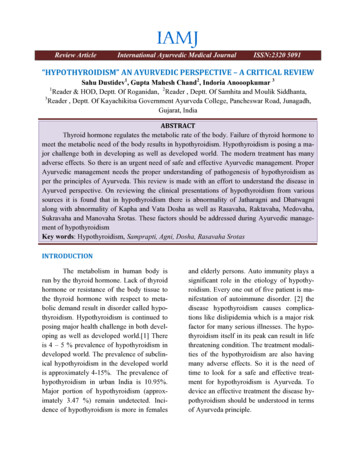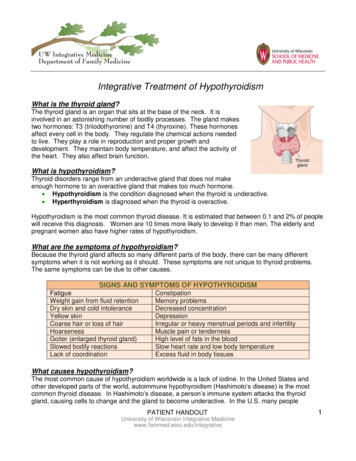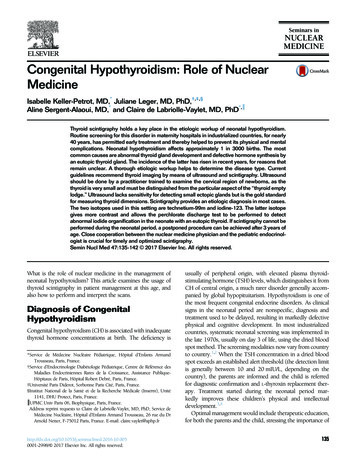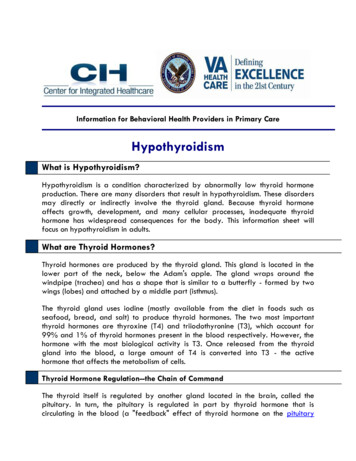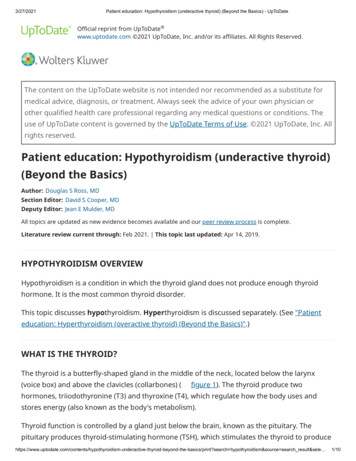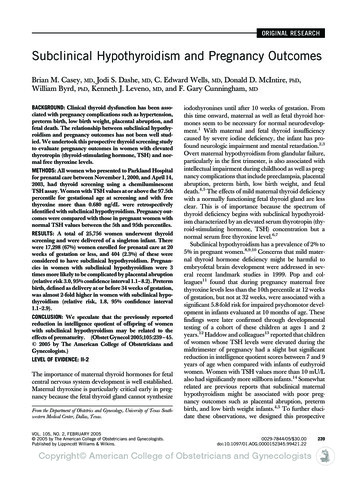
Transcription
ORIGINAL RESEARCHSubclinical Hypothyroidism and Pregnancy OutcomesBrian M. Casey, MD, Jodi S. Dashe, MD, C. Edward Wells, MD, Donald D. McIntire, PhD,William Byrd, PhD, Kenneth J. Leveno, MD, and F. Gary Cunningham, MDBACKGROUND: Clinical thyroid dysfunction has been associated with pregnancy complications such as hypertension,preterm birth, low birth weight, placental abruption, andfetal death. The relationship between subclinical hypothyroidism and pregnancy outcomes has not been well studied. We undertook this prospective thyroid screening studyto evaluate pregnancy outcomes in women with elevatedthyrotropin (thyroid-stimulating hormone, TSH) and normal free thyroxine levels.METHODS: All women who presented to Parkland Hospitalfor prenatal care between November 1, 2000, and April 14,2003, had thyroid screening using a chemiluminescentTSH assay. Women with TSH values at or above the 97.5thpercentile for gestational age at screening and with freethyroxine more than 0.680 ng/dL were retrospectivelyidentified with subclinical hypothyroidism. Pregnancy outcomes were compared with those in pregnant women withnormal TSH values between the 5th and 95th percentiles.RESULTS: A total of 25,756 women underwent thyroidscreening and were delivered of a singleton infant. Therewere 17,298 (67%) women enrolled for prenatal care at 20weeks of gestation or less, and 404 (2.3%) of these wereconsidered to have subclinical hypothyroidism. Pregnancies in women with subclinical hypothyroidism were 3times more likely to be complicated by placental abruption(relative risk 3.0, 95% confidence interval 1.1– 8.2). Pretermbirth, defined as delivery at or before 34 weeks of gestation,was almost 2-fold higher in women with subclinical hypothyroidism (relative risk, 1.8, 95% confidence interval1.1–2.9).CONCLUSION: We speculate that the previously reportedreduction in intelligence quotient of offspring of womenwith subclinical hypothyroidism may be related to theeffects of prematurity. (Obstet Gynecol 2005;105:239 – 45. 2005 by The American College of Obstetricians andGynecologists.)LEVEL OF EVIDENCE: II-2The importance of maternal thyroid hormones for fetalcentral nervous system development is well established.Maternal thyroxine is particularly critical early in pregnancy because the fetal thyroid gland cannot synthesizeFrom the Department of Obstetrics and Gynecology, University of Texas Southwestern Medical Center, Dallas, Texas.VOL. 105, NO. 2, FEBRUARY 2005 2005 by The American College of Obstetricians and Gynecologists.Published by Lippincott Williams & Wilkins.iodothyronines until after 10 weeks of gestation. Fromthis time onward, maternal as well as fetal thyroid hormones seem to be necessary for normal neurodevelopment.1 With maternal and fetal thyroid insufficiencycaused by severe iodine deficiency, the infant has profound neurologic impairment and mental retardation.2,3Overt maternal hypothyroidism from glandular failure,particularly in the first trimester, is also associated withintellectual impairment during childhood as well as pregnancy complications that include preeclampsia, placentalabruption, preterm birth, low birth weight, and fetaldeath.4,5 The effects of mild maternal thyroid deficiencywith a normally functioning fetal thyroid gland are lessclear. This is of importance because the spectrum ofthyroid deficiency begins with subclinical hypothyroidism characterized by an elevated serum thyrotropin (thyroid-stimulating hormone, TSH) concentration but anormal serum free thyroxine level.6,7Subclinical hypothyroidism has a prevalence of 2% to5% in pregnant women.8,9,10 Concerns that mild maternal thyroid hormone deficiency might be harmful toembryofetal brain development were addressed in several recent landmark studies in 1999. Pop and colleagues11 found that during pregnancy maternal freethyroxine levels less than the 10th percentile at 12 weeksof gestation, but not at 32 weeks, were associated with asignificant 5.8-fold risk for impaired psychomotor development in infants evaluated at 10 months of age. Thesefindings were later confirmed through developmentaltesting of a cohort of these children at ages 1 and 2years.12 Haddow and colleagues13 reported that childrenof women whose TSH levels were elevated during themidtrimester of pregnancy had a slight but significantreduction in intelligence quotient scores between 7 and 9years of age when compared with infants of euthyroidwomen. Women with TSH values more than 10 mU/Lalso had significantly more stillborn infants.14 Somewhatrelated are previous reports that subclinical maternalhypothyroidism might be associated with poor pregnancy outcomes such as placental abruption, pretermbirth, and low birth weight infants.4,5 To further elucidate these observations, we designed this prospective0029-7844/05/ 30.00doi:10.1097/01.AOG.0000152345.99421.22239
Fig. 1. Median, 5th, 95th, and97.5th percentile thyrotropin values according to weeks of gestationat screening in 17,298 women whopresented for prenatal care at orbefore 20 weeks. TSH, thyroidstimulating hormone (thyrotropin).Casey. Subclinical Hypothyroidism andPreterm Birth. Obstet Gynecol 2005.screening study of a large obstetric population to evaluate pregnancy outcomes in women with subclinical hypothyroidism.MATERIALS AND METHODSParkland Health and Hospital System is a tax-supportedinstitution serving the medically indigent in DallasCounty. The Department of Obstetrics and Gynecologyat the University of Texas Southwestern Medical Schoolsupervises the delivery of all women’s health care at 10clinic sites throughout Dallas County and at ParklandHospital. Beginning with enrollment for prenatal care atthese sites, obstetric care for women delivered at Parkland Hospital is coordinated throughout pregnancy, delivery, and the puerperium by members of the Divisionof Maternal Fetal Medicine.All women who present for prenatal care, regardlessof gestational age, undergo immediate prenatal laboratory testing including screening for rubella status. Withthe approval of the Institutional Review Boards at theUniversity of Texas Southwestern and Parkland Hospital, excess serum from each rubella screen was deliveredto an immunochemistry research laboratory in the Department of Obstetrics and Gynecology for thyroid testing. Thyroid function studies were performed usingchemiluminescent assays for TSH and free thyroxine.Specifically, these assays were performed using an Immulite 2000 Analyzer (Diagnostic Products Corporation, Los Angeles, CA). The analytical sensitivity of theTSH assay was 0.002 mU/L. The coefficient of variationwas 3.8% within a run and 4.6% between runs using240Casey et alSubclinical Hypothyroidism and Preterm Birthspecimens in the normal range. The sensitivity limit forfree thyroxine was 0.18 ng/mL. The within-run coefficient of variation was 7.1% and was 6.4% between runs.Serum samples from women screened for a 1-monthperiod (October 2000) were analyzed to estimate the95th percentile value for TSH (uncorrected for gestational age) in our obstetric population (3.0 mU/L). Serum from women (November 1, 2000 to April 14, 2003)with TSH values above 3.0 mU/L was prospectivelyassayed for free thyroxine. Those women with both anabnormally elevated TSH and a low free thyroxine ( 0.9 ng/dL) were contacted for referral to a special obstetric complications clinic for evaluation and treatment.The Institutional Review Boards at the University ofTexas Southwestern and Parkland Hospital approvedthis identification and referral of women with clinicalhypothyroidism.Women who were screened at 20 weeks of gestationor less and delivered a singleton infant weighing 500 g ormore during the screening period were analyzed. For thepurposes of this study, women with TSH values at orabove the 97.5th percentile for gestational age at screening and with free thyroxine more than 0.680 ng/dL wereretrospectively identified with subclinical hypothyroidism. The free thyroxine threshold of 0.680 ng/dL wasestablished using the 2nd percentile from available freethyroxine values of women in the study cohort. The97.5th percentile for TSH corrected for gestational agevaried between 2.74 mU/L and 5.09 mU/L (Fig. 1).Pregnancy outcomes in women identified with subclinical hypothyroidism were compared with those inOBSTETRICS & GYNECOLOGY
women with TSH values between the 5th and 95thpercentiles.Selected obstetric and neonatal outcomes for allwomen delivering infants at Parkland Hospital are routinely entered into a computerized perinatal database.Nurses attending each delivery complete an obstetricdata sheet and research nurses assess the data for consistency and completeness before electronic storage. Dataon infant outcomes are abstracted from dischargerecords. Results from thyroid function studies (TSH andfree thyroxine) were electronically stored and linked tothe perinatal and infant databases.Gestational age at screening was established using theobstetric estimate of gestational age recorded at delivery.This gestational age is based on the woman’s certain lastmenstrual period (LMP), with sonography performed ifthere are discrepancies between fundal height and LMPor if the LMP is uncertain. This method of gestationalage determination has been found to correlate well withsonographic and pediatric estimates in our population.15Gestational hypertension was defined as an intrapartumsystolic blood pressure of at least 140 mm Hg or adiastolic blood pressure of at least 90 mm Hg. Severepreeclampsia was diagnosed in women with hypertension who had at least 1 of the following: blood pressuremore than 160/110 mm Hg, serum creatinine more than1.0 mg%, platelet count less than 100,000/ L, serumaspartate aminotransferase level at least twice the uppernormal value, persistent headache or scotomata, 2 orgreater proteinuria, or more than 2 g of protein excretedin 24 hours. Preterm birth was defined as gestational ageof 34 weeks or less at delivery. Infants with majormalformations included those with aneuploidy, an identifiable syndrome, and those with an anomaly involvinga principal organ system.16Pearson’s 2 and Student t tests were used for univariate 2-group comparisons. Logistic regression was applied to examine the significance for preterm birth adjusted for age, race, and placental abruption. TheHosmer-Lemeshow statistic examined the goodness-offit for the logistic regression models.17 Statistical computations were performed using SAS 8.2 (SAS Institute,Cary, NC). A 2-tailed P .05 was judged statisticallysignificant.RESULTSAs shown in Figure 2, between November 1, 2000, andApril 14, 2003, a total of 25,756 women underwentthyroid screening and delivered a singleton infant atParkland Hospital. Of these, 17,298 (67%) enrolled forprenatal care at 20 weeks gestation or less and 436 (2.5%)had screening TSH values at or above the 97.5th percen-VOL. 105, NO. 2, FEBRUARY 2005Fig. 2. Outcome of thyroid screening in women who presented for prenatal care and delivered a singleton infantbetween November 1, 2000, and April 14, 2003. TSH,thyroid-stimulating hormone (thyrotropin).Casey. Subclinical Hypothyroidism and Preterm Birth. Obstet Gynecol 2005.tile threshold for their gestational age in weeks (Fig. 2).Of these, 32 (0.2%) had a free thyroxine less than orequal to 0.680 ng/dL and were considered to have overthypothyroidism. These women were referred for evaluation and treatment and thus excluded from this analysis. Therefore, 404 women with TSH values at the97.5th percentile and normal free thyroxine were considered to have subclinical hypothyroidism and served asthe study group. The TSH levels in these women rangedfrom 2.74 mU/L to more than 75 mU/L. Shown inFigure 3 is the distribution of TSH values for womenwith either overt or subclinical hypothyroidism. Oneeighth of women with subclinical hypothyroidism (n 50) had TSH values greater than 10 mU/L. A significantmajority of women with overt hypothyroidism had TSHvalues of 10 mU/L or greater (P .001).Women with subclinical hypothyroidism are compared with 15,689 pregnant controls identified with TSHvalues between the 5th and the 95th percentiles in Table1. The incidence of subclinical hypothyroidism washigher in white women and those classified as “Other”ethnicity. Also, women with subclinical hypothyroidismwere significantly older than control women. For example, 11% of women with an elevated TSH value wereaged 35 years or greater compared with only 7% ofCasey et alSubclinical Hypothyroidism and Preterm Birth241
Fig. 3. Thyrotropin values for 404 women diagnosed withsubclinical hypothyroidism and 32 women diagnosed withovert hypothyroidism. Boxes represent 25th to 75th percentile. TSH, thyroid-stimulating hormone (thyrotropin).Casey. Subclinical Hypothyroidism and Preterm Birth. Obstet Gynecol 2005.healthy controls. (P .009). There was no differencebetween the groups in relation to parity or body massindex. The gestational age at screening was similar between the 2 groups.Listed in Table 2 are selected pregnancy outcomes inwomen with subclinical hypothyroidism compared withcontrols. The incidence of gestational hypertension andsevere preeclampsia was similar between the 2 groups.Pregnancies in women with subclinical hypothyroidismwere 3 times more likely to be complicated by placentalabruption when compared with healthy pregnantwomen. (relative risk 关RR兴 3.0, 95% CI 1.1– 8.2). Although the mean gestational age at delivery was notsignificantly different between the 2 groups, pretermbirth, defined as delivery at or before 34 weeks of gestation, was almost 2-fold higher in women with subclinicalhypothyroidism. (RR 1.8, 95% CI 1.1–2.9). Specifically,18 (4%) women with a TSH at or above the 97.5thpercentile and a normal free thyroxine level deliveredpreterm compared with 385 (2.5%) controls (P .01).These significant differences persisted after adjustmentfor maternal age, race, and placental abruption (HosmerLemeshow goodness of fit, P .97). Furthermore, preterm birth remained significantly higher in women withsubclinical hypothyroidism and a TSH value less than10 mU/L.Infant outcomes are compared in Table 3. Neonatesdelivered of women with subclinical hypothyroidism weresimilar in birth weight to infants of women with normalTSH values. Other conditions consistent with prematuritywere increased in infants of women with subclinical hypothyroidism. For example, admission to the neonatal intensive care nursery and respiratory distress were twice aslikely in infants delivered of women with subclinical hypothyroidism (RR 1.8, 95% CI 1.1–2.9 and 1.0 –3.3, respectively). Fetal death rates were the same (5/1,000 births) inboth groups, and the neonatal death rates, although higherin infants of women with subclinical hypothyroidism (5/1,000 compared with 2/1,000 live births), were not significantly different.DISCUSSIONThere are several important findings from this prospective analysis of more than 17,000 women who underwent screening for abnormal thyroid function during thefirst half of pregnancy. First, subclinical hypothyroidismwas identified in 2.3% of the population tested, and thiscorresponds with virtually all previous reports.8,9,14 Second, women with subclinical hypothyroidism had a significant, almost 2-fold higher incidence of preterm delivery at or before 34 weeks of gestation. A third findingwas a significant 3-fold increase in the incidence of pla-Table 1. Maternal Characteristics of Women Who Underwent Thyroid-Stimulating Hormone Screening at or Before 20Weeks of GestationMaternal DemographicsSubclinical Hypothyroidism (n 404)Normal TSH (n 15,689)PAge (y)ⱖ 35Race or ethnicity:HispanicAfrican AmericanWhiteOtherNulliparityWeeks at enrollmentBody mass index (kg/m2)26.9 5.944 (11)25.5 5.61,161 (7) .001.009 .001341 (84)27 (7)16 (4)20 (5)145 (36)12.2 4.032.1 6.313,472 (86)1,588 (10)321 (2)308 (2)5,672 (36)11.9 3.831.7 5.5.915.211.163TSH, thyroid-stimulating hormone.Values are mean standard deviation or n (%). Women with a TSH value at or above the 97.5th percentile and normal free thyroxine(subclinical hypothyroidism) are compared with those with a TSH between the 5th and 95th percentiles (normal).242Casey et alSubclinical Hypothyroidism and Preterm BirthOBSTETRICS & GYNECOLOGY
Table 2. Pregnancy Outcomes in Women Who Underwent Thyroid-Stimulating Hormone Screening at or Before 20 Weeksof Gestation.Pregnancy OutcomeHypertensionGestationalSevere preeclampsiaPlacental abruptionWeeks gestation at delivery36 or less34 or less32 or lessCesarean deliveryRepeatPrimaryDystociaFetal distressOtherSubclinical Hypothyroidism (n 404)Normal TSH (n 15,689)P41 (11)23 (6)4 (1)39.3 2.227 (7)18 (4)10 (2.5)108 (27)59 (15)1,400 (9)842 (5)52 (0.3)39.4 1.9891 (6)385 (2.5)218 (1)3,853 (25)1,923 (12).397.774.026.226.390.011.068.316.15616 (4)17 (4)16 (4)716 (5)647 (4)567 (4)0.5660.9330.713TSH, thyroid-stimulating hormone.Values are mean standard deviation or n (%). Women with a TSH value at or above the 97.5th percentile and normal free thyroxine levels(subclinical hypothyroidism) are compared with those with a TSH between the 5th and 95th percentiles (normal).cental abruption in women in the subclinical hypothyroid group compared with healthy controls. Related tothe second 2 findings, the proportion of infants of hypothyroid mothers admitted to the neonatal intensive careunit, as well as those who developed respiratory distresssyndrome, was significantly doubled when comparedwith infants of euthyroid women.It is important to emphasize that our findings includeonly infants born to women with subclinical hypothyroidism as contemporaneously defined.6,7 We excludedwomen with abnormally elevated serum TSH levelsaccompanied by abnormally low free thyroxine levelsbecause they were considered to have hypothyroidism.This distinction is important and may explain why ourresults differ from Allan and colleagues,14 who reportedincreased stillbirths in hypothyroid women. Specifically,in their retrospective study they did not distinguishsubclinical hypothyroidism from overt disease. Thislikely accounts for their findings that the incidence ofstillbirth was significantly increased only in the groupof women whose TSH levels exceeded 10 mU/L, manyof whom probably had overt hypothyroidism. (Fig. 3).Importantly, the increased risk for preterm birth inwomen identified with subclinical hypothyroidism inthis study persisted even in those women with TSHvalues less than 10 mU/L.Table 3. Neonate Outcomes in Women Who Underwent Thyroid-Stimulating Hormone Screening at or Before 20 Weeks ofGestation.Neonate OutcomeSubclinical Hypothyroidism (n 404)Normal TSH (n 15,689)PBirth weight (g)ⱕ 1,000ⱕ 1,500ⱕ 2,500Admission to intensive careApgar score at 5 minutes ⱕ 3Umbilical artery blood pH 7.00Respiratory distress syndrome*Necrotizing enterocolitis†Intraventricular hemorrhage‡Major malformationsFetal deathNeonatal deaths3,317 5992 (0.5)7 (2)26 (6)16 (4)3 (0.7)8 (2)11 (3)002 (0.5)2 (0.5)2 (0.5)3,367 56770 (0.4)142 (1)839 (5)347 (2)109 (0.7)263 (2)235 (1.5)5 (0.03)11 (0.1)177 (1)78 (0.5)37 995.295TSH, thyroid-stimulating hormone.Values are mean standard deviation or n (%). Women with a TSH value at or above the 97.5th percentile and normal free thyroxine levels(subclinical hypothyroidism) are compared with those with a TSH between the 5th and 95th percentiles (normal).* Ventilator greater than 24 hours of life.†Necrotizing enterocolitis requiring surgery.‡Grade 3 or 4 intraventricular hemorrhage.VOL. 105, NO. 2, FEBRUARY 2005Casey et alSubclinical Hypothyroidism and Preterm Birth243
Although it is too early to measure any neurodevelopmental abnormalities that might develop in children ofwomen with subclinical thyroid deficiency, data nowpresented may help to elucidate the findings of others.Specifically, Haddow and colleagues13 reported that children of women with abnormally high TSH levels duringpregnancy had significantly lower intelligence quotientscores compared with controls born to euthyroid mothers.Similarly, Pop et al11 reported that abnormally low maternal serum free thyroxine concentrations at 12 weeks ofgestation were significantly associated with impaired neurodevelopment in infants at 10 months. In this country,preterm birth is overwhelmingly the most common recognized cause of neuropsychologic dysfunction in children.18,19 We therefore propose that this significant increase in preterm birth could potentially contribute to theseneurodevelopmental abnormalities or may amplify abnormalities caused by thyroxine deficiency. Indeed, Haddowand colleagues attempted to correct for prematurity byexcluding births less than 1,500 g. Only long-term follow-up of those children could resolve this issue.The most cogent question is whether identificationand thyroid hormone supplementation of women withsubclinical hypothyroidism would prevent or modifyany of these adverse outcomes. It may be that therapybeginning after 10 weeks of gestation would not eliminate any already established fetal neurodevelopmentalimpairment from hypothyroxinemia. Pop and colleagues11 have provided evidence that treatment may beineffective only if given after this time. Because themechanism of disease whereby thyroid hormone deficiency leads to preterm labor, placental abruption, andother pregnancy complications is not known, we canonly speculate about any salutary effects of thyroxinereplacement. One unifying hypothesis is that thyroidhormone is necessary for normal placental development.Specifically, there is evidence that preterm delivery andvascular diseases such as preeclampsia and placentalabruption may be causally linked to faulty early placentation.20,21 Although our findings may provide furtherincentive to screen for subclinical hypothyroidism inpregnancy, there are currently no randomized controlledtreatment trials to substantiate such a policy. We are ofthe view that until studies are done to demonstrate thatthyroxine supplementation will obviate any of thesematernal and fetal morbidities, widespread serum TSHscreening and treatment of women with subclinical hypothyroidism during pregnancy is unjustified.REFERENCES1. Utiger RD. Maternal hypothyroidism and fetal development. N Engl J Med 1999;341:601– 02.244Casey et alSubclinical Hypothyroidism and Preterm Birth2. Xue-Yi C, Xin-Min J, Zhi-Hong D, Rakeman MA,Ming-Li Z, O’Donnell K, et al. Timing of vulnerability ofthe brain to iodine deficiency in endemic cretinism. N EnglJ Med 1994;331:1739 – 44.3. DeLong GR, Stanbury JB, Fierro-Benitez R. Neurologicalsigns in congenital iodine-deficiency disorder. Dev MedChild Neurol 1985;27:317–24.4. Davis LE, Leveno KJ, Cunningham FG. Hypothyroidismcomplicating pregnancy. Obstet Gynecol 1988;72:108 –12.5. Leung AS, Millar LK, Koonings PP, Montoro M, Mestman JH. Perinatal outcome in hypothyroid pregnancies.Obstet Gynecol 1993;81:349 –53.6. Cooper DS. Subclinical hypothyroidism. N Engl J Med2001;345:260 –5.7. Surks MI, Ortiz E, Daniels GH, Sawin CT, Col NF, CobinRH, et al. Subclinical thyroid disease: scientific review andguidelines for diagnosis and management. JAMA 2004;291:228 –38.8. Klein RZ, Haddow JE, Faix JD, Brown RS, Hermos RJ,Pulkkinen A, et al. Prevalence of thyroid deficiency inpregnant women. Clin Endocrinol (Oxf) 1991;35:41– 6.9. Woeber KA. Subclinical thyroid dysfunction. Arch InternMed 1997;157:1065– 8.10. Canaris GJ, Manowitz NR, Mayor G, Ridgway EC. TheColorado thyroid disease prevalence study. Arch InternMed 2000;160:526 –34.11. Pop VJ, Kuijpens JL, van Baar Al, Verkerk G, van SonMM, de Vijlder JJ, et al. Low maternal free thyroxineconcentrations during early pregnancy are associated withimpaired psychomotor development in infancy. ClinEndocrinol (Oxf) 1999;50:149 –55.12. Pop VJ, Brouwers EP, Vader HL, Vulsma T, van BaarAL, de Vijlder J. Maternal hypothyroxinaemia duringearly pregnancy and subsequent child development: a3-year follow-up study. Clin Endocrinol (Oxf) 2003;59:282– 8.13. Haddow JE, Palomaki GE, Allan WC, Williams JR,Knight GJ, Gagnon J, et al. Maternal thyroid deficiencyduring pregnancy and subsequent neuropsychologicaldevelopment of the child. N Engl J Med 1999;341:549 –55.14. Allan WC, Haddow JE, Palomaki GE, Williams JR,Mitchell ML, Hermos RJ, et al. Maternal thyroid deficiency and pregnancy complications: implications for population screening. J Med Screen 2000;7:127–30.15. McIntire DD, Bloom SL, Casey BM, Leveno KJ. Birthweight in relation to morbidity and mortality among newborn infants. N Engl J Med 1999;340:1234 – 8.16. Koster EL, McIntire DD, Leveno KJ. Recurrence of mildmalformations and dysplasias. Obstet Gynecol 2003;102:363– 6.17. Hosmer DW, Lemeshow S. Applied logistic regression.New York (NY): Wiley; 1989.OBSTETRICS & GYNECOLOGY
18. Victorian Infant Collaborative Study Group. Anderson P,Doyle LW, Neurobehavioral outcomes in school-agedchildren born extremely low birthweight or very pretermin the 1990s. JAMA 2003;289:3264 –72.19. Bhutta AT, Cleves MA, Casey PH, Cradock MM, AnandKJ. Cognitive and behavioral outcomes of school-agedchildren who were born preterm: a meta-analysis. JAMA2002;288:728 –37.20. Walker JJ. Pre-eclampsia. Lancet 2000;356:1260 – 65.21. Dommisse J, Tiltman AJ. Placental bed biopsies in placental abruption. Br J Obstet Gynaecol 1992;99:651– 4.Address reprint requests to: Brian M. Casey, MD, The University of Texas Southwestern Medical Center, Department ofObstetrics & Gynecology, 5323 Harry Hines Blvd., Dallas,Texas 75390 –9032; e-mail: brian.casey@utsouthwestern.eduReceived September 20, 2004. Received in revised form November 12,2004. Accepted November 18, 2004.Submit Your Manuscript to Obstetrics & GynecologyTo accelerate the review process, authors are encouraged to submit their manuscripts directly via the Internet at http://ong.editorialmanager.com. Editorial Manager , our online manuscript submission and tracking system, is a top-of-the-line program currently used by morethan 500 journals.TMVisit Editorial Manager directly by going to http://ong.editorialmanager.com or via thejournal’s home page (www.greenjournal.org)TMFirst-time users: Click the “Register” button on the menu bar and enter the requestedinformation. Upon successful registration, you will be sent an e-mail with instructions toverify your registration.Authors: Click the “Login” button on the menu bar and log in to the system as “Author.”Then submit your manuscript and track its progress through the system.Some advantages of submitting your manuscript electronically include:· Instant submission with no need to mail your manuscript· Ability to track the status of your manuscript through the review process· Instant notification via e-mail regarding the status of your manuscriptThe author agreement form and checklist appear on the journal’s web site (www.greenjournal.org)and in the January and July issues.VOL. 105, NO. 2, FEBRUARY 2005Casey et alSubclinical Hypothyroidism and Preterm Birth245
ered to have subclinical hypothyroidism and served as thestudygroup.TheTSHlevelsinthesewomenranged from 2.74 mU/L to more than 75 mU/L. Shown in Figure 3 is the distribution of TSH values for women with either overt or subclinical hypothyroidism. One eighth of women with subclinical hypothyroidism (n 50) had TSH values greater than 10 mU/L. A .
